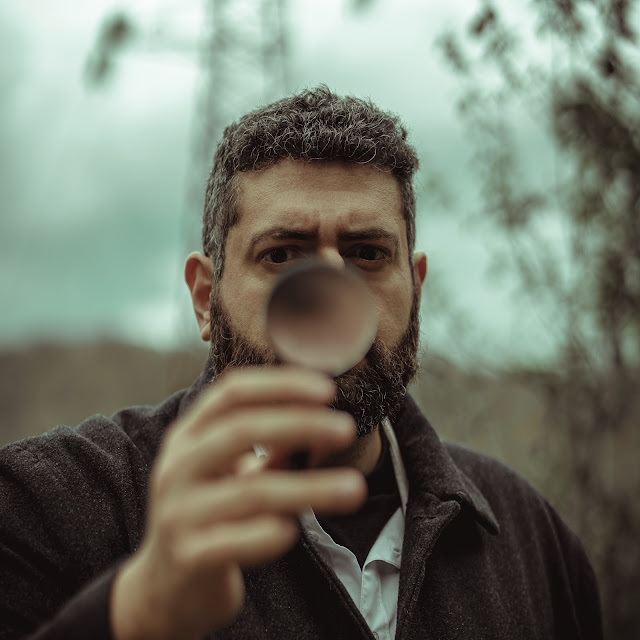Andrea Zacchia – Anemoia (Filibusta Records, 2025)
Tra vento e memoria, un trio che scolpisce il tempo con suoni sospesi e silenzi densi di senso
Ci sono dischi che non ti chiedono di ascoltarli: ti invitano a entrare in una stanza silenziosa, dove ogni nota è un frammento di memoria che forse non ti appartiene, eppure senti di riconoscere. Anemoia, il nuovo lavoro del chitarrista Andrea Zacchia, è esattamente questo: un diario in codice, fatto di risonanze interiori più che di fatti concreti, sospeso tra il ricordo e l’immaginazione.
Dopo l’ottimo HBPM (recensito qui) – dove all’Hammond sedeva Angelo Cultreri – Zacchia torna con una nuova formazione in trio: Pietro Caroleo all’organo Hammond e Maurizio De Angelis alla batteria. Un assetto che apre a un suono più maturo, essenziale e visionario. La scelta di pubblicare con Filibusta Records segna un’evoluzione: un ponte verso un’estetica più definita e un jazz capace di contenere il silenzio, la memoria e lo spazio.
Il termine anemoia, che unisce in greco “vento” (ánemos) e “mente” (nóos), diventa la chiave poetica dell’intero progetto: nostalgia per qualcosa che non abbiamo mai conosciuto. E così la musica scorre come brezza gentile, avvolgendo l’ascoltatore in un viaggio tra modale e post-bop, tra strutture aperte e interplay serrato.
Reveries, brano d’apertura, è già manifesto poetico: la chitarra di Andrea Zacchia si muove con tocco leggero, quasi a non voler spezzare l’incantesimo, mentre l’Hammond di Pietro Caroleo dipinge paesaggi armonici ampi e la batteria di Maurizio De Angelis suggerisce direzioni con delicatezza narrativa. Sembra di assistere a una jam notturna in un club di New York, anni ’90, con il silenzio fuori e la pioggia sui vetri.
Nei tributi, Zacchia e il trio evitano la trappola della citazione sterile. Oleo (Sonny Rollins) pulsa di energia vitale, con l’Hammond a dare una densità quasi viscerale, mentre la chitarra si muove con fraseggio nervoso e moderno, senza indulgere nei cliché bebop.
Full House (Wes Montgomery) è una riflessione in musica: i vuoti tra le note parlano tanto quanto i pieni, con un uso sapiente del sustain e del vibrato che lascia sospesa ogni tensione.
Le composizioni originali, però, sono il cuore pulsante del disco. Abendrot – “rosso del tramonto” – è un piccolo quadro impressionista: armonie flessibili, trame sottili e un senso di malinconia che si fa bellezza pura.
Blues for Wes, omaggio dichiarato a Montgomery, preferisce la gratitudine all’imitazione: il blues diventa un linguaggio da riscrivere, tra groove e aperture liriche.
Con Groove Yard (Carl Perkins), il trio s’impadronisce del tema e lo rende terreno fertile per un interplay serrato. L’Hammond costruisce una tessitura ritmica cremosa ma mai pesante, mentre la chitarra racconta una storia urbana fatta di luci soffuse e risate lontane: il jazz come spazio sociale oltre che musicale.
Longato è uno dei passaggi più personali del disco, in cui si fonde l’energia primitiva del rock con aperture jazzistiche sofisticate. La costruzione dinamica crea un climax emotivo ben calibrato. È un ritorno alle origini, al luogo simbolico da cui tutto nasce. Longato non è solo una località: è uno stato dell’anima, dove la musica diventa viaggio e confessione.
Il disco si chiude con Zefiro, il vento primaverile che porta con sé leggerezza e memoria. Qui la chitarra sussurra più che parlare, e l’Hammond assume un ruolo quasi cinematografico. È un ritorno a casa, o forse il sogno di una casa mai vista.
 |
| Andrea Zacchia - hammond trio |
Questo è un lavoro che rifugge le urla per abbracciare la sincerità. Non cerca di stupire con l’esibizione tecnica, ma di suggerire, evocare, plasmare uno spazio sonoro in cui l’ascoltatore possa specchiarsi e perdersi. È jazz che non teme il silenzio e trova la sua forza proprio lì, negli interstizi tra una nota e l’altra. Zacchia sembra voler ricordare che, in un mondo musicale sempre più frenetico e ossessionato dal virtuosismo, c’è ancora spazio per un approccio intimo e contemplativo, dove la tecnica diventa linguaggio e non esercizio di stile.
In questo senso il trio si muove con grande naturalezza, come un organismo vivo: le atmosfere rarefatte si alternano a momenti di intensa energia collettiva, costruendo paesaggi sonori in cui ciascuno può proiettare il proprio immaginario. È un disco che respira, che invita a rallentare, a sostare tra melodie sospese e armonie ricche di sfumature.
Il titolo – quel termine che unisce “vento” e “mente” – è già di per sé una dichiarazione poetica: nostalgia per ciò che non si è mai conosciuto. E forse questa musica riesce proprio a catturare quel sentimento impalpabile, restituendolo in forma di suono. Qui non ci sono mete precise né risposte, ma piuttosto un invito a lasciarsi attraversare da un flusso di immagini, memorie e risonanze interiori. Come un vento leggero che scompiglia i pensieri e ci riporta al cuore stesso dell’ascolto.
Registrato, missato e masterizzato presso il Fusion Music Studio di Monterotondo (RM) da Federico Palmieri, il disco beneficia di una produzione attenta ai dettagli e capace di esaltare la dinamica naturale del trio. L’equilibrio tra gli strumenti è reso con una chiarezza che non sacrifica mai il calore e la profondità del suono, restituendo all’ascoltatore la sensazione di trovarsi in una dimensione intima, quasi dal vivo.
Distribuito fisicamente da I.R.D. e digitalmente da Altafonte Italia, l’album è disponibile sia in formato digitale che in CD.
La grafica del CD è altrettanto evocativa: un cielo verde-azzurro, carico di nuvole e attraversato da tralicci elettrici, incornicia il volto assorto di Andrea Zacchia. La natura e l’elemento industriale coesistono in un equilibrio sospeso, proprio come la musica che si muove tra contemplazione e tensione. È un’immagine che richiama l’idea di vento e di spazi aperti, simboli perfetti per un lavoro che sembra nascere ai confini tra realtà e immaginazione.
 |
| Andrea Zacchia |
Track list:
Reveries
Oleo (Sonny Rollins)
Full House (Wes Montgomery)
Abendrot
Blues for Wes
Groove Yard (Carl Perkins)
Longato
Zefiro
Formazione:
Andrea Zacchia – chitarra
Pietro Caroleo – Hammond
Maurizio De Angelis – batteria
Andrea Zacchia – Anemoia (Filibusta Records, 2025)
Between wind and memory, a trio that sculpts time with suspended sounds and meaningful silences
Some records don’t ask to be listened to—they invite you into a quiet room, where every note feels like a fragment of memory that may not belong to you, yet you recognize it. Anemoia, the new work by guitarist Andrea Zacchia, is exactly that: a coded diary, made of inner resonances more than concrete facts, suspended between memory and imagination.
Following the excellent HBPM (reviewed here)—where the Hammond was played by Angelo Cultreri—Zacchia returns with a new trio lineup: Pietro Caroleo on Hammond organ and Maurizio De Angelis on drums. This ensemble opens up to a more mature, essential, and visionary sound. The decision to release the album with Filibusta Records marks an evolution: a bridge toward a more defined aesthetic, and a kind of jazz that embraces silence, memory, and space.
The word anemoia, combining the Greek “ánemos” (wind) and “nóos” (mind), becomes the poetic key to the entire project: a nostalgia for something we’ve never known. And so the music flows like a gentle breeze, enveloping the listener in a journey through modal and post-bop territories, between open structures and tight interplay.
Reveries, the opening track, is already a poetic manifesto: Zacchia’s guitar moves with a light touch, as if not to break the spell, while Caroleo’s Hammond paints wide harmonic landscapes, and De Angelis’s drumming offers direction with narrative delicacy. It feels like witnessing a late-night jam in a New York club in the ’90s, with silence outside and rain tapping on the windows.
In the tributes, Zacchia and the trio avoid the trap of sterile quotation. Oleo (Sonny Rollins) pulses with vital energy, the Hammond adding a visceral density, while the guitar phrases nervously and modernly, sidestepping bebop clichés.
Full House (Wes Montgomery) becomes a musical meditation: the spaces between the notes speak as much as the notes themselves, with masterful use of sustain and vibrato that suspends tension in the air.
The original compositions, however, are the beating heart of the album. Abendrot—German for “sunset red”—is like a small impressionist painting: flexible harmonies, delicate textures, and a sense of melancholy that turns into pure beauty.
Blues for Wes, a declared homage to Montgomery, opts for gratitude over imitation: the blues becomes a language to be rewritten, blending groove with lyrical openness.
With Groove Yard (Carl Perkins), the trio takes full ownership of the theme and turns it into fertile ground for tight interplay. The Hammond crafts a creamy yet never heavy rhythmic fabric, while the guitar tells an urban story made of dim lights and distant laughter: jazz as a social space, not just musical.
Longato is one of the album’s most personal moments, blending the raw energy of rock with sophisticated jazz inflections. The dynamic build-up creates a well-balanced emotional climax. It’s a return to the roots, to the symbolic place where everything begins. Longato is not just a town—it’s a state of mind, where music becomes both journey and confession.
The album closes with Zefiro, the spring wind that brings lightness and memory. Here, the guitar whispers more than it speaks, and the Hammond takes on a cinematic role. It’s a return home—or perhaps a dream of a home never seen. This is a work that shuns shouting in favor of sincerity. It doesn’t aim to impress with technical display, but to suggest, evoke, and shape a sonic space where the listener can reflect and lose themselves. It’s jazz that doesn’t fear silence and draws its strength precisely from the spaces between one note and the next. Zacchia seems to remind us that in a musical world increasingly obsessed with speed and virtuosity, there is still room for an intimate, contemplative approach—where technique becomes language rather than a show of style.
In this sense, the trio moves with remarkable naturalness, like a living organism: rarefied atmospheres alternate with bursts of collective energy, building soundscapes into which each listener can project their own imagination. This is a breathing album, one that invites us to slow down, to pause among suspended melodies and richly shaded harmonies.
The title itself—merging "wind" and "mind"—is already a poetic statement: nostalgia for something never known. And perhaps this music truly captures that elusive feeling, giving it shape in sound. There are no fixed destinations or clear answers here, only an invitation to be carried along by a flow of images, memories, and inner echoes. Like a light wind that stirs the thoughts and brings us back to the heart of listening.
Recorded, mixed, and mastered at Fusion Music Studio in Monterotondo (Rome) by Federico Palmieri, the album benefits from meticulous production that enhances the trio’s natural dynamics. The balance between instruments is rendered with clarity, never sacrificing warmth or depth, and offers the listener an intimate, almost live dimension.
Physically distributed by I.R.D. and digitally by Altafonte Italia, the album is available both digitally and on CD.
The CD artwork is equally evocative: a greenish-blue sky, heavy with clouds and crisscrossed by electrical towers, frames the introspective face of Andrea Zacchia. Nature and industry coexist in a suspended equilibrium—just like the music, which navigates between contemplation and tension. It’s an image that perfectly reflects the idea of wind and open space, symbols of a work born at the edge of reality and imagination.
Track list:
Reveries
Oleo (Sonny Rollins)
Full House (Wes Montgomery)
Abendrot
Blues for Wes
Groove Yard (Carl Perkins)
Longato
Zefiro
Personnel:
Andrea Zacchia – guitar
Pietro Caroleo – Hammond organ
Maurizio De Angelis – drums

